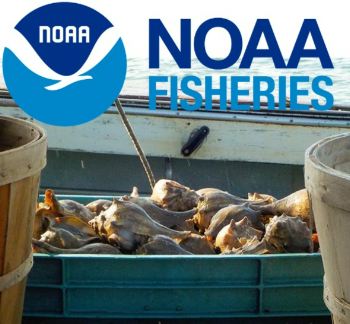|

Photo courtesy from NOAA Fisheries
Conch Fishing: An Observer's Perspective
 UNITED STATES
UNITED STATES
Thursday, March 16, 2023, 07:00 (GMT + 9)
Marine snails may not be the first thing you think of when you think about commercial fishing in the Northeast. Fisheries observer Jessica Tyrrell provides an insider’s perspective on a little known, yet important fishery.
When you think of commercial fishing, images of big draggers dumping piles of fish on deck may come to mind. Or maybe you’ve watched an episode or two of Wicked Tuna and think of that. Marine snails usually aren’t the first thing you think of when someone mentions fishing, but it is an important fishery on the Atlantic seaboard.
I’m a fisheries observer and I recently sailed out of Cape May, New Jersey, on a vessel targeting marine snails. Many fishermen and scientists call them conch. As we steamed out, the captain told me that we’ll mostly catch “knobbies”—knobbed whelk. He’d rather catch “smoothies”—channeled whelk—because the price is a lot better.
“Smoothies” or channel whelks are an edible marine snail. Their range extends along the U.S. East Coast from Massachusetts to Florida. Credit: NOAA Fisheries/Jessica Tyrrell
It was a fairly blustery start to the morning. As we hit wave after wave, I had to keep checking my equipment, making sure it wasn’t spread out all over the deck. I bring quite a bit of equipment out on each observing trip: scales, baskets, measuring boards, etc. I need it all to effectively do my job measuring, weighing, and accounting for any bycatch that comes up in the traps.
Stacks of plastic conch traps at a fishing port in New Jersey. Credit: NOAA Fisheries/Jessica Tyrrell
As we started hauling the first round of traps, the weather settled down and turned into a beautiful sunrise, albeit a chilly one. The traps come up with a mechanical hauler on the side of the boat. These traps are a mix of square wire mesh, and plastic round ones. Traps can be quite inventive. They vary from boat to boat, but all have the same general design: a large entrance usually at the top, slats on the sides to allow small animals to easily escape, and a way to secure bait.
Bait is essential for conch fishing. It can vary almost as much as the traps. Horseshoe crabs are the most common type of bait, but I’ve seen captains use sea robins, menhaden, spiny dogfish, and clam bellies. Today they are using menhaden and horseshoe crabs. On a hot day the smell of bait can be quite overpowering. Luckily for me the frosty air makes it barely noticeable.
Stacks of plastic conch traps at a fishing port in New Jersey. Credit: NOAA Fisheries/Jessica Tyrrell
As the traps come up, the crew throws the unwanted catch into a basket for me to separate out the different whelk species, get weights and take shell widths on kept and discarded species. Most of the discards, or unwanted catch, are snails too small to keep. Occasionally an oyster toadfish pops up. I’m careful to avoid their crushing bite and venomous spines while handling them. To account for what the captain and crew keep, I get an average weight for a tote and count the total number of filled totes. Snails smell pretty ripe, even when they’re alive. We can all tell when the boat starts to fill up.
Oyster toadfish are a common inshore fish native to the East Coast of the United States. They’re one of the bycatch species in the whelk fishery. Credit: NOAA Fisheries/Jessica Tyrrell
As we head for home, a lone dolphin swims by. I take a minute to appreciate this strange but fun way of fishing, and I hope I’ve inspired some of you to appreciate it too.
|



